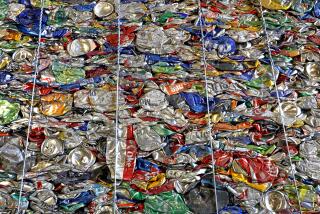Recycling Gets Heap of Support : Trash: Curbside program in Anaheim enjoys 90% compliance rate. Irvine residents have recycled enough paper to save 192,000 trees.
ANAHEIM — Not since Disneyland opened or the Los Angeles Rams moved to town has an idea caught on here so quickly. Curbside recycling, based on a three-month pilot program, is the biggest success in a long, long while.
Since September, more than 90% of the 11,000 city households in the test program have dutifully put their used bottles, cans and newspapers in special barrels for curbside collection, making it by all accounts one of the most successful starts to such an effort in California, officials say.
“There’s just thousands of tons of garbage being diverted,” said City Councilwoman Miriam Kaywood, a strong proponent of the city’s recycling push. The curbside collection plan has gone so well that officials plan to expand it citywide to more than 65,000 households in April.
Anaheim is one of six Orange County cities offering some form of collection for recyclable items including glass bottles and jars, aluminum and tin cans, plastic soda and milk containers, newspapers and even cardboard. An estimated 175,000 to 200,000 county residents voluntarily participate in curbside recycling programs in Anaheim, Brea, Costa Mesa, Laguna Beach, Orange and Irvine, which was the first city in the county to adopt a program in September, 1987.
Mounting concern about the glut of trash and shortage of landfills has prompted a growing number of municipalities statewide to launch recycling efforts. About 140 cities now have programs, triple the number just two years ago. And more cities are bound to join the trend after passage last year of tough new state laws that require all cities to establish recycling programs by 1992 and reduce by half the amount of solid waste being taken to landfills before the year 2000.
Nowhere is the trash heap bigger than Orange County, where 4.4 million tons of solid waste are generated every year. That’s roughly 2.1 tons for every man, woman and child--the highest per capita ratio of any county in the nation.
So it’s no wonder officials are delighted with the remarkable success of Anaheim’s pilot project. One reason may be how easy it is for residents to store and separate their garbage.
Unlike other cities, Anaheim requires residents only to divide their trash into two 110-gallon barrels--a green one for recyclable goods and a black one for the rest of the trash, which is still collected once a week. Recyclable goods are picked up every other week.
“The program is very convenient,” said Rita Tagge, recycling coordinator for Anaheim Disposal Company, the private firm that operates the city’s program. “Any type of metal, plastic, paper, glass or cardboard . . . they can just throw it all in one can.”
Workers at the disposal company then separate the trash at its transfer station. Since the program began in September, Tagge estimated, about 850 tons of trash bound for county landfills instead has been recycled.
Studies have shown that the more consumers are asked to sort and store, the less likely they are to participate, so Anaheim opted for two barrels rather than three used by the city of Irvine. In Costa Mesa, residents don’t even separate their garbage; the trash company sorts out recyclables for residents. But such programs cost more, and experts say requiring consumers to separate their garbage helps educate them to the importance of recycling.
Anaheim and the disposal company evenly divide revenues collected from recycled garbage, but so far the city, like most others, has not seen a profit and doesn’t expect to for some time. Recycling revenues, however, can help reduce increases in trash collection fees.
Anaheim officials say it will take about 18 months to bring all 65,000 households into the program. But so far, the 90% participation rate is nearly double the state average for cities with similar programs, though most experts believe that over time some residents are bound to lose interest and drop out.
More to Read
Sign up for Essential California
The most important California stories and recommendations in your inbox every morning.
You may occasionally receive promotional content from the Los Angeles Times.











